William Maley
Staff Writer - CheersandGears.com
August 21, 2012
One nameplate that has seen its share of ups and downs in Nissan’s lineup is the Quest. Introduced back in 1993 as a contender in the Minivan marketplace, the Quest came out of partnership between Nissan and Ford. For nine years, the Quest enjoyed success as being an alternative to the stalwarts of the class; the Chrysler Town & Country, Dodge Caravan and Plymouth Voyager.
When it came time to introduce the next Quest, Nissan went down a very different path. Arriving in 2003, the second generation Quest did ‘shift’ what a minivan could be. The styling was out there for a van, looking like Nissan asked a group of art school students to design a production-ready van. Even more surprising was how much fun the Quest was to drive. Hampered by its unusual looks, the second-generation Quest didn’t do well in sales and Nissan pulled it off the market in 2009.
So that brings us to the third-generation Quest. Introduced last year, the new Nissan Quest takes another try with an unconventional look. The question is, will it work?
Next: Step Outside
Exterior
The Nissan Quest’s design is very distinctive from its contemporaries, looking like Nissan imported one of its vans from Japan. Well, that is what Nissan is doing with the Quest; an Americanized version of the Japanese market Elgrand van.
Starting with the front end, Nissan wisely decided to remove the chromed-out front end on the Elgrand and go for a pentagonal grille, with chrome trim running around the perimeter. Nissan also swapped out the huge stacked headlights and went for a set of projector headlights.
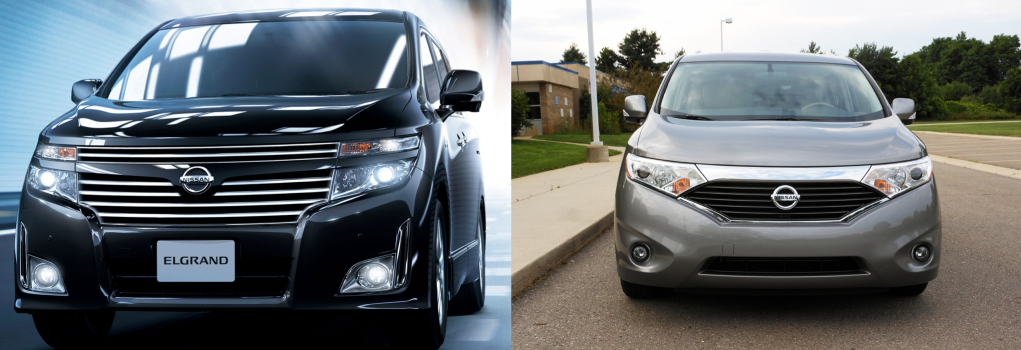
The side profile of Quest features wrap-around glass running from the front door all the way to the tailgate. The glass helps disguise the B, C, and D-Pillars. There are also two character lines; one starting from where the hood and front end meet to the front door and other starting from the taillights and running along the sliding door. Finally, Nissan fitted ground effects and a set of seventeen-inch alloy wheels.

The back end of Quest drops Elgrand’s full length taillights. Instead, Nissan goes for a regular pair of taillights which are separated by a chrome bar that hides the release for the power tailgate.

Next: Come On In
Interior
The seating arrangement is the Quest’s strongest and weakest point. Up front, driver and passenger are seated in leather-wrapped, heated, and powered seats. (Driver gets eight-way with memory, passenger gets four-way). For the second row, it’s a set of captain chairs that can recline and move forward and back to make yourself comfortable. The third row is a bench seat which can fit three kids or two adults. Headroom is very generous due to high roof. Legroom is very good for the first two rows. In the third row, legroom can vary due to how far the second row seats are set back. Adults can sit back here comfortably if the seats are set all the way forward or have been pushed back slightly. If the seats are pushed all the way back, then it’s really only comfortable for kids.
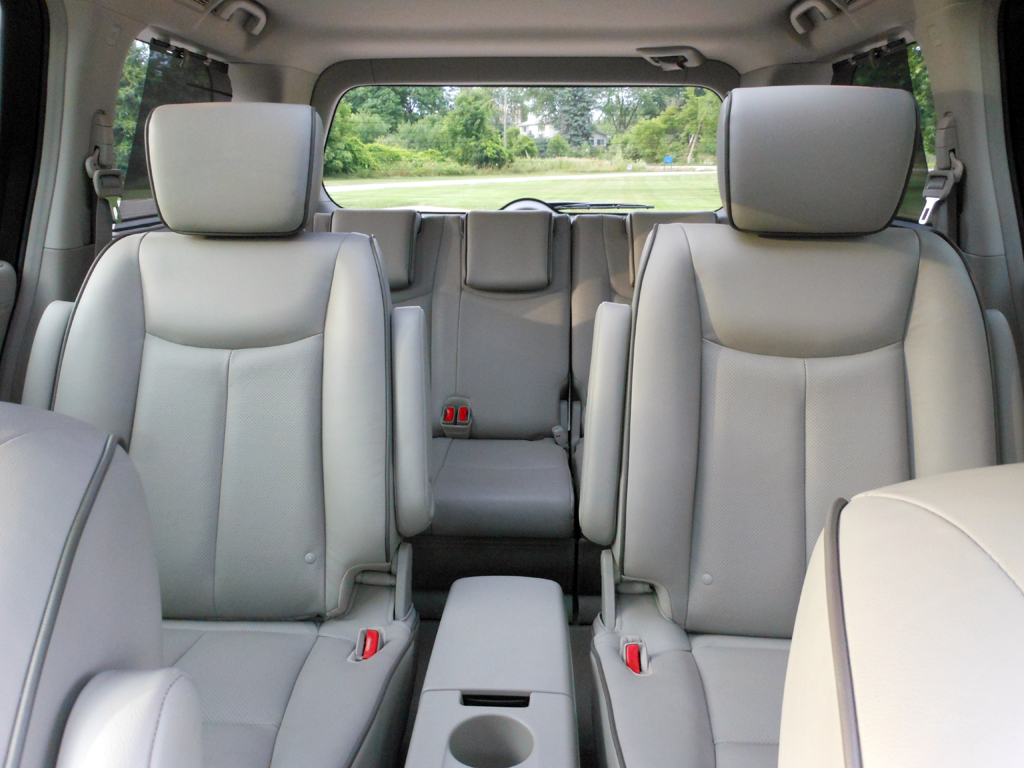
Nissan has also outfitted the backseat area with some surprising luxuries. For starters, passengers sitting back have their own control for the HVAC system, power windows for the second row, and pull-up shades for the second and third-row windows.
However, the seating arrangement also highlights the Quest’s biggest weakness, cargo space.

*Underfloor Luggage area is included in the Quest’s measurement
With all of the seats up, the Quest is right behind the Odyssey and Sienna in cargo space. But when it comes time to load up more cargo, the Quest loses big time. The reason is due to the second and third row seats being permanently locked in, meaning you can’t take the seats out of the Quest or fold them into the floor. The only thing you can do to the seats is to fold them down.
Materials used throughout ranged from leather on the door pulls, soft touch materials on the dash, and hard plastics on the non-touch point. All of the materials look like they belong on a $43,000 minivan. Build quality is very high with no gaps nor pieces coming apart.
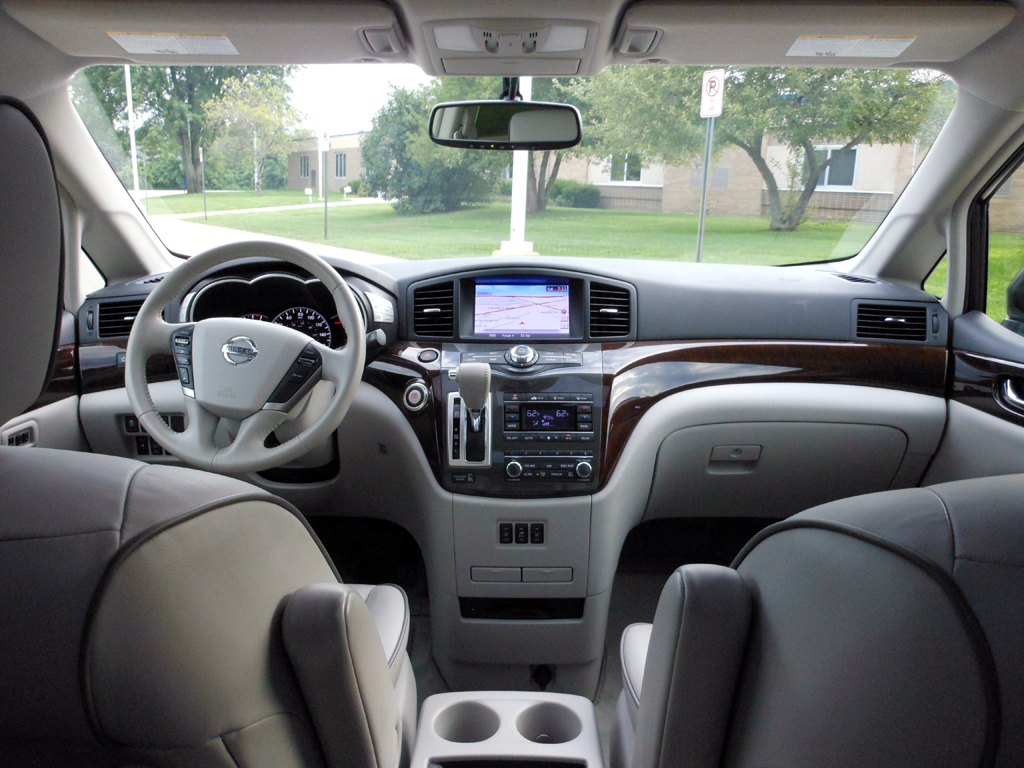
One item that drove me crazy during the week I had the Quest was the placement of the shifter. Nissan places the right next to the controls for the HVAC and Radio. Put the Quest into drive, and the shifter blocks your view of the controls and forces you to reach around to get to them.
For your entertainment, the Quest LE comes equipped with a 4.3-inch touchscreen that provides navigation, car information, and AM/FM/SiriusXM Satellite Radio/CD/MP3/USB/Bluetooth. All of that audio comes out a 13-speaker Bose system which fills the car with very good sound quality. Back seat passengers can watch a movie on a DVD entertainment system which includes an 11-inch screen and wireless headphones.
Next: Vroom, Vroom
Engine
The Quest comes with only one powertrain; a 3.5L VQ V6 producing 260 HP and 240 lb-ft of torque. That power is sent to Nissan’s Xtronic CVT transmission which is then routed to the front wheels.
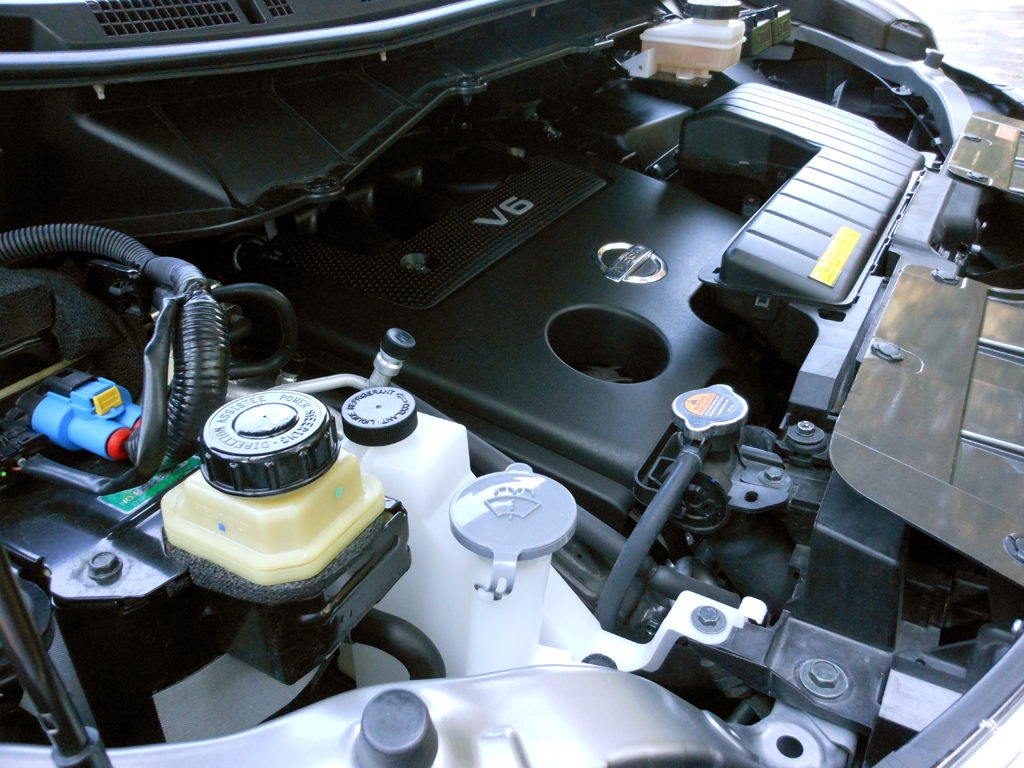
For a van that tips the scales at 4,568 lbs, the 3.5L V6 had no problem of getting up to speed at all. Whenever you needed the power to leave a stop or make a pass, the 3.5L was always at the ready. As for the CVT, it was a good partner to the 3.5L. The CVT made sure you are always in the power and provided a nice smoothness.
Fuel economy for the 3.5L is 19 City/24 Highway/21 combined. Our average for the week was 21.3 MPG, mostly on highway and rural roads.
Next: Time to Drive
Ride & Drive
The Quest’s ride is comfortable and confident, thanks in part to the Quest’s independent four-wheel suspension made up of MacPherson struts at the front and a multi-link setup in the back. Even driving on some back roads which haven’t been paved in a while, the Quest’s suspension isolated the bumps and ruts very well. As for sound insulation, the Quest does a good job of minimizing the amount of road and wind noise. Engine noise is also kept to a minimum.
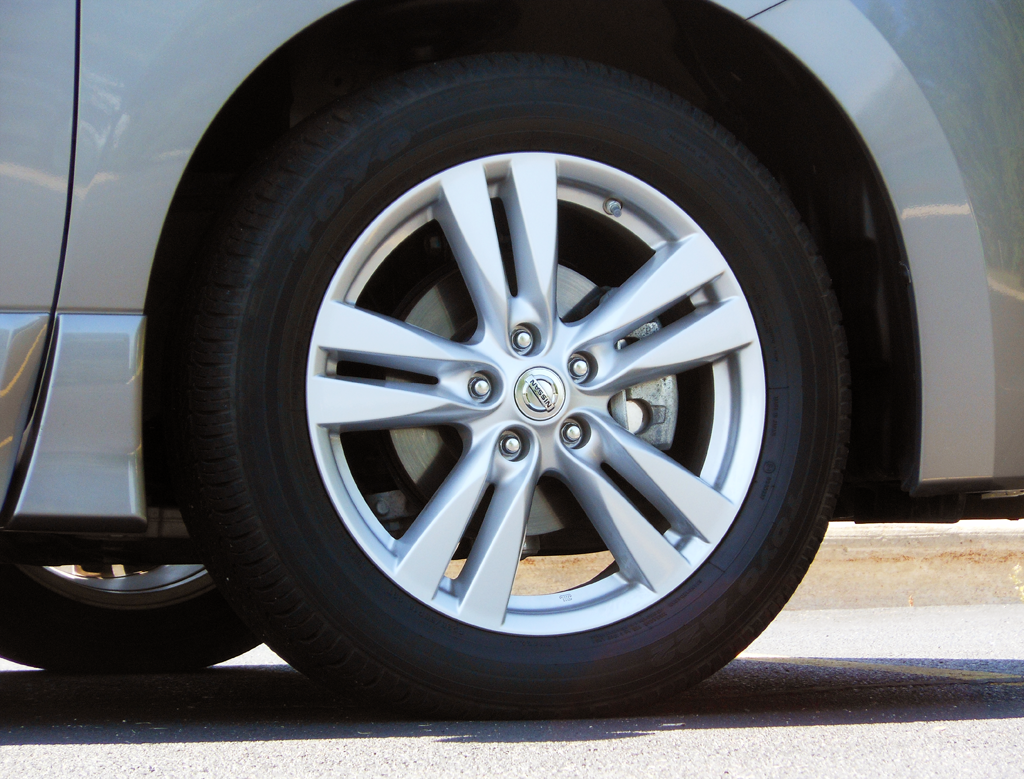
Steering comes in the form of a speed-sensitive, power-assisted rack and pinion setup. The setup provides the right amount of weight for the situation and good road feel.
Visibility is very good for the front and side of the Quest. Rear visibility is tricky due to large D-Pillars. Thankfully, Nissan fits a rear-view camera as standard equipment on the Quest ranging from the top of the line LE to the mid-level SV. One item I wish Nissan would fit on to the Quest is its around-view system, which provides views of the sides and back. Not only would the system make it easier to backup, but also would add a measure a safety when backing out of certain situations, like a family gathering.
Next: The Verdict
Verdict
The Nissan Quest dares to be different in the minivan class and it mostly pays off. The interior and the appointments place the Quest at the top of the class. Plus, the 3.5L V6 and Xtronic CVT make the Quest a pleasure to drive.
But the Quest does have a big flaw. Due to the seats being permanently locked in place, the cargo capacity is severely limited. This could be a deal breaker for most buyers since you lose out on a good amount of cargo space because you cannot take them out of the vehicle. Other competitors offer much more space because you can either remove or fold the seats into the floor.
The Quest is the best in class if your primary concern is to have the most luxuries in a minivan. If luxury isn’t your primary concern, look to another van.

Cheers
Interior
Interior Features
Powertrain
Ride
Jeers
Cargo Space
Placement of the shifter
Disclaimer: Nissan provided the vehicle, insurance, and one tank of gas
Year - 2012
Make – Nissan
Model – Quest
Trim – LE
Engine – 3.5L VQ V6
Driveline – Front Wheel Drive, Xtronic CVT
Horsepower @ RPM - 260 @ 6000
Torque @ RPM – 240 @ 4400
Fuel Economy: City/Highway/Combined - 19/24/21
Curb Weight – 4568 lbs
Location of Manufacture – Kyushu, Japan
Base Price - $41,350.00
As Tested Price - $43,715.00 (Includes $810.00 Destination Charge)
William Maley is a staff writer for Cheers & Gears and a connoisseur of minivans. He can be reached at [email protected] or you can follow him on twitter at @realmudmonster.



-3707742431.jpg.06edf8e14f4ccf35c60d4774a543cc11.jpg)



Recommended Comments
Join the conversation
You can post now and register later. If you have an account, sign in now to post with your account.
Note: Your post will require moderator approval before it will be visible.